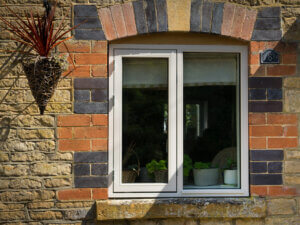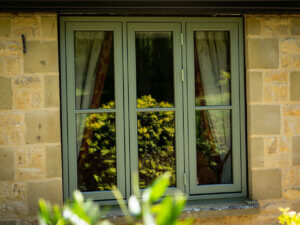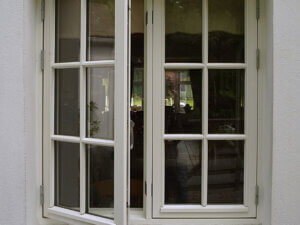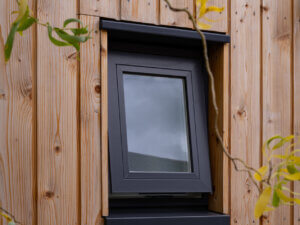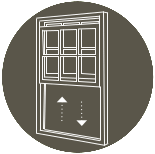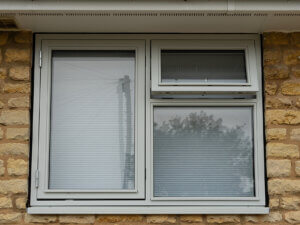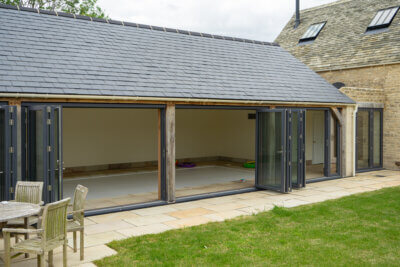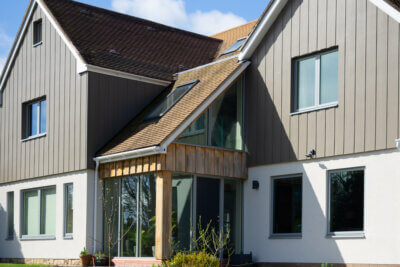Configuration Options for Bespoke Windows
Bespoke windows can quickly become an agony of choice in many areas, but perhaps the most impactful to your day-to-day is how you’ll be able to use them. There are many different types of hinges to choose from, and hopefully we’ve done an excellent job of explaining how they work below! As always, if our explanations need catering specifically to your project, you are always welcome to give us a call or drop us an email.
Fixed Sash
See more in our Minimalist Cotswold Cottage Renovation gallery.
Fixed windows are the most cost-effective way to glaze any opening: with no moving parts and no hardware, they can allow for truly enormous glass areas at a relatively low price. They can also be used in conjunction with other opening options to keep costs manageable.
Fixed windows will look slightly different to an opening window, but if you’re worried about the look a false sash (or “dummy sash”) is always available.
False Sash
See more in our Cotswold Countryside Window Renovation gallery.
False sash windows are generally a normal outward opening frame fixed into place, this means their cost will be slightly more than a fixed sash but less than a moving sash. False sash windows allow for a more continuous look to the windows on a home with less variation between items, see our Cherington Brick Barn Conversion
Fixed and False sash windows both allow for huge glass expanses to be covered in glass, in some cases over 3 meters in width and height.
Side Hung
See more in our Isle of Man Country Cottage Double Glazing Upgrade gallery.
Side hung windows use a hinge system to allow for opening, they commonly have some form of friction break which holds the window in place to stop it from closing in the wind when you close the handle in any position. Side hung windows also allow for the largest opening area allowing for fire egress in a smaller area than a side guided window.
Side hung windows that do not have a friction break will almost universally come with a window stay this allows the user to lock the window into position much like a friction break.
Side Guided
See more in our Sleek, Modern and Uniformly-Designed Leicestershire New Build gallery.
Side guided windows use a sliding mechanism to allow them to open, this slightly increases the cost of production. the sliding mechanism also moves the pivot point of the window away from a side mounted hinge and toward the center of the window, this allows them to be slightly wider at maximum size but reduces the opening area.
Both side guided and hung windows can be used in a false mullion configuration, this allows two windows to act as a single opening with a moving central partition, we regularly find that customers like this feature as it allows them to keep more traditional designs involving more smaller windows while getting fire egress or larger airflow when necessary.
Matching side guided and top hung or reverse windows is a commonly done thing amongst our customers, it allows for a range of opening options to fit any size opening. while less common we do have customers who have mixed side hung and side guided, usually on differing faces of a home as the hinges of a side hung window can look out of place on a home with mostly side guided windows.
Top Guided
See more in our Bradford upon Avon Timber-Clad Barn Conversion gallery.
Top guided windows use the same mechanism as a side guided window, but they cannot open to such a wide extent, with a common maximum swing of around 45 degrees, they give the lowest opening area of any opening window, the advantage of a top guided window is that it can be very large, with maximum single item sizes sometimes exceeding 1800mm wide and 1600mm high. The greater maximum size of these windows can be brilliant for a more modern style o home with large glass areas.
Top guided windows are commonly used as a way to allow for some constant airflow into bathrooms or bedrooms as a top vent.
They can also be mixed with side hung or side guided windows to give a customer a variety of opening styles.
Top Reverse
A top reverse or top swing windows uses a similar guided opening style to the guided windows except it also allows the user to turn the window a full almost 180degrees, this allows for easy cleaning of the external part of the window.
Top reverse windows are regularly used on taller buildings or where gaining external access to clean the windows would be dangerous or difficult.
Most top swing windows are made such that to swing the window around to a greater degree the user must press in on specific areas, this is to help stop someone from unintentionally opening the window far enough to fall from.
Top opening windows generally allow for the largest glass are of any non fixed window, this allows for a huge amount of light to to enter the home and a large opening area for when you need to get fresh air into a room.
Top guided and top reverse windows will usually look the same externally as side guided windows.
Tilt Turn
See more of our German Composite Series Tilt Turn Windows.
Tilt turn mechanisms are the most technically difficult of window mechanisms. They have a three-position handle: allowing the window to tilt inwards for some small constant airflow or to turn inwards allowing for a large open area.
Tilt turn windows like most side opening windows can be made with a false mullion, this allows for a much larger opening to be made; generally when a tilt turn window is configured with a false mullion only the master side can tilt, the slave side is only able to turn.
Our Multifaceted Barn Conversion Gallery has contains more images of tilt-turn windows for those interested.
Sliding Sash
See more of our Vrogum Solborg Airtight Sliding Sash Window Windows.
A sliding sash window opening mechanism has the top, bottom or both sashes of the window able to move up and down, this allows for a little under 50% of the window to be open at any one time. our Vrogum Solborg sliding sash windows also have a secure “night-vent” open position where the window can be locked open, leaving a 20mm gap. Sliding sash windows are a classical English style that has been in use for hundreds of years. On our options, the lower sash can be tilted inwards to make cleaning the unit far easier.
There is no good comparison to make here, Tilt-turn and Sliding Sash windows are truly as far apart in window terms as you can get, but the one thing they both have in common is that they are more expensive than an outward opening window of similar quality due to how complicated their mechanisms are.
Both of these window types have their own place in heritage or specialised builds around the UK, and in some cases combining outward opening windows with either Tilt-Turn or Sliding sash can be a fantastic option.
Outward Opening Combinations
See more in our Long Compton Wooden Window Energy Efficiency Upgrade gallery.
Outward opening combination units are used in almost every build, from the most common of having a side opening window next to fixed window as a cost saving measure, through designs like the one above where a top guided element is added for as a vent, to the most complex designs that get used in larger openings.
Our suppliers are all able to combine their outward opening and fixed window options into a huge variety of designs, the few restrictions in-place are mostly due to the minimum and maximum size of each element.
Inward Opening Combinations
See more of our German Composite Series Tilt Turn Windows.
Inward opening combinations in windows are perhaps a little less interesting than their Outward opening counterparts, mostly due to the lack of options from most companies. All of our tilt-turn providers are able to configure a combination unit of fixed lights and tilt-turns and we almost always use this feature to save on costs for our clients, a tilt-turn window mechanism is of-course more expensive than a fixed window so we tend to configure windows similarly to the item above, this could have been 3 tilt-turn elements side by side, but to save cost and as the client didn’t need that many openers we instead designed a window that would give a large opening for when it was needed but also had a large fixed light to use the majority of the space, this has the added benefit of increasing the natural light that can enter the home.
Mixing inward and outward opening casements
We noted above that you can’t mix inward and outward opening units, while this is the case in a single casement, we can fix two or more separate units together to make an otherwise unmakeable unit, for instance we could split a larger opening into a fixed light with a top guided element above it and place to the side a tilt turn door, much like the one shown below. We find this is quite a common request when a large opening is available as it allows for more options of use, a small window opening for a little airflow, or a large door opening for those days when you need a breeze to cool off.
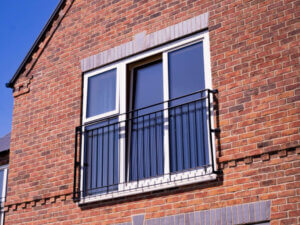
See more in our Sleek, Modern and Uniformly-Designed Leicestershire New Build gallery.
Our Recent Projects
Our most recent galleries are shown below, you can also find all of our project galleries here.
Fixed | False Sash | Side Guided | Side Hung | Top Guided | Top Reverse | Tilt Turn | Sliding Sash | |
| STM Tinium | ||||||||
| Unik Funkis | ||||||||
| STM Sapino | ||||||||
| German Composite Series | ||||||||
| German Timber Series | ||||||||
| Vrogum Classic | ||||||||
| Vrogum Svarre | ||||||||
| Vrogum Solborg |
Contact us!
For any questions about our products and services, or to get your quote,
please get in touch by phone, email, or using our in-browser contact form!
Leamington: 01926 935 607
London: 0203 633 0476
E-mail : sales@enlightenedwindows.co.uk
Contact Form: Contact Us



